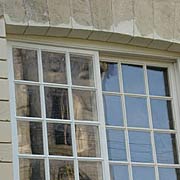
|
contents | technologies | |||||||||
| Cylinder glass  This type of glass is the most difficult to give an exact date for, as both crown glass and cylinder glass were made and used alongside each other until the 20th century when crown glass appeared less and less. Until the late 1700s crown glass was dominant, after which it was pushed out of the market by cylinder glass. Unfortunately, the exact recipes and production techniques for crown glass have been lost and genuine crown glass is no longer made. This leaves cylinder glass as the only acceptable alternative. This type of glass is the most difficult to give an exact date for, as both crown glass and cylinder glass were made and used alongside each other until the 20th century when crown glass appeared less and less. Until the late 1700s crown glass was dominant, after which it was pushed out of the market by cylinder glass. Unfortunately, the exact recipes and production techniques for crown glass have been lost and genuine crown glass is no longer made. This leaves cylinder glass as the only acceptable alternative.Cylinder glass is made by a craftsman blowing a bottle-shaped cylinder. Once the cylinder is ready, the two ends are cut off and the cylinder is scored. This allows the cylinder, when reheated, to flap open to give a flat piece of glass, which is then annealed. This glass has a fair amount of imperfections and the ream and seed give it its distinctive characteristics. Histoglass supplies 10mm thin double glazing for the restoration of historic buildings. Histoglass is designed to be installed into existing timber and metal frames without altering the fine detailing of the glazing bars. It is the only product of its kind to fully comply with BS EN 1279 (parts 1-6) and is covered by a 7 year manufacturers warranty. The systems are available in a wide range of thicknesses and glass types to suit the age of a building, each with differing thermal and acoustic insulation properties. Warm-edge technology is now standard for conventional double glazing, however, Histoglass uses an aluminium spacer with a secondary seal. write your comments about the article :: © 2012 Construction News :: home page |